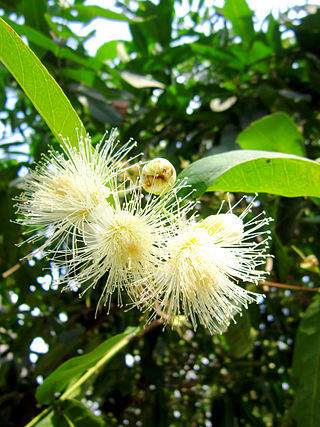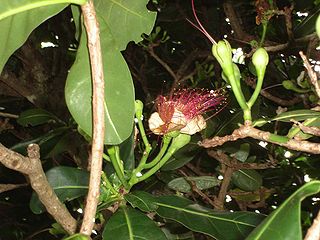
Syzygium samarangense is a species of flowering plant in the family Myrtaceae, native to an area that includes the Greater Sunda Islands, Malay Peninsula, and the Andaman and Nicobar Islands, but introduced in prehistoric times to a wider area and now widely cultivated in the tropics. Common names in English include wax apple, Java apple, Semarang rose-apple, and wax jambu.

Antidesma is a genus of tropical plant in the family Phyllanthaceae formally described by Linnaeus in 1753. It is native to tropical Africa, S + E + SE Asia, Australia, and various oceanic islands. The greatest diversity occurs in Southeast Asia.

Canarium is a genus of about 120 species of tropical and subtropical trees, in the family Burseraceae. They grow naturally across tropical Africa, south and southeast Asia, Indochina, Malesia, Australia and western Pacific Islands; including from southern Nigeria east to Madagascar, Mauritius, Sri Lanka and India; from Burma, Malaysia and Thailand through the Malay Peninsula and Vietnam to south China, Taiwan and the Philippines; through Borneo, Indonesia, Timor and New Guinea, through to the Solomon Islands, Vanuatu, New Caledonia, Fiji, Samoa, Tonga and Palau.

Cryptocarya is a genus of evergreen trees belonging to the laurel family, Lauraceae. The genus includes more than 350 species, distributed through the Neotropical, Afrotropical, Indomalayan, and Australasian realms.

Mount Harriet National Park, officially renamed as Mount Manipur National Park, is a national park located in the Andaman and Nicobar Islands union territory of India. The park, established in 1969, covers about 4.62 km2 (18.00 mi2). Mount Manipur, which is a part of the park, is the third-highest peak in the Andaman and Nicobar archipelago next to Saddle Peak in North Andaman and Mount Thullier in Great Nicobar.

Chionanthus, common name: fringetrees, is a genus of about 140 species of flowering plants in the family Oleaceae.
The putative Wych Elm cultivar Ulmus glabra 'Dovaei', or Doué elm, was raised by the André Leroy nursery at Angers, France, as Ulmus dovaei, before 1868. The Baudriller nursery of Angers marketed it as Ulmus Dowei, "orme de Doué", suggesting a link with the royal nurseries at nearby Doué-la-Fontaine, which stocked elm. Green considered it a form of wych.

Actinodaphne is an Asian genus of flowering plants in the laurel family (Lauraceae). It contains approximately 125 species of dioecious evergreen trees and shrubs.

Pterocarpus dalbergioides, the Andaman padauk, Andaman redwood or East Indian mahogany, is a species of flowering plant in the family Fabaceae. It is sometimes called "narra", but this is just a generic term used for any of several Pterocarpus species. It is native to the Andaman Islands.

Barringtonia is a genus of flowering plants in the family Lecythidaceae first described as a genus with this name in 1775. It is native to Africa, southern Asia, Australia, and various islands of the Pacific and Indian Oceans. The genus name commemorates Daines Barrington.

Bentinckia nicobarica is a species of flowering plant in the family Arecaceae endemic to the Nicobar Islands in the Bay of Bengal. It is a palm native to Great Nicobar, Katchal, Nancowry and Car Nicobar islands.
Minervarya charlesdarwini is a species of frogs in the family Dicroglossidae. It is endemic to the Andaman Islands, India, and is known from the South Andaman Island, Long Island, and North Andaman Island.

Phoenix andamanensis is a wild relative of date palm endemic to the Andaman Islands in the Bay of Bengal southwest of Myanmar. It is rather a newly described taxon by Sasha C. Barrow in 1998 based on old herbarium collections. This taxon was known only from a few herbarium collections and a few insignificant citations by Kurz in 1870, Brandis in 1906 and Parkinson in 1923. The Herbarium collections were made mostly during the British regime in 1903, 1904 and 1911 by Rogers and Osmaton. Later, Ellis from the Botanical Survey of India in 1990 collected one specimen from the Saddle Peak. The specimens were remained unidentified at herbaria until its circumscription as new taxon by Barrow in 1998.

Elaeocarpus angustifolius is a species of flowering plant in the family Elaeocarpaceae and occurs from India to New Caledonia and northern Australia. Common synonyms are E. ganitrus and E. sphaericus. It is a large evergreen tree, often with buttress roots, and has leaves with wavy serrations, creamy white flowers and more or less spherical bright blue drupe fruit. In English, the tree is known as utrasum bean tree in India. In Sri Lanka recorded names are woodenbegar and Indian bead tree. It is simply known as elaeocarpus in the Northern Territory of Australia. Other names used for this tree in Australia are Indian oil fruit and genitri. In Hawaii it is known as a blue marble tree.

Pinanga andamanensis is one of the critically endangered species of endemic palms reported from the Andaman Islands.

Ganophyllum falcatum, commonly known as the scaly ash, is an evergreen rainforest tree. It grows up to 32 metres high and has rough, flaky bark. The species was described by German-Dutch botanist Carl Ludwig Blume in 1851 based on plant material collected from the coast of New Guinea.It is native to Africa, the Andaman Islands, Asia, Malesia and northern Australia. The ovoid fruits are consumed by fruit pigeons and cassowaries.
Drypetes ellisii is lesser known endemic tree of the family Euphorbiaceae described from the Andaman Islands in the Bay of Bengal. The type locality of this species is Mount Harriet National Park. This taxon is rather rare in occurrence grows up to 10m in height.
Rotala andamanensis is a lesser-known endemic wetland plant species of the Andaman Islands in the Bay of Bengal belonging to the family Lythraceae. The type locality of this species is Wright Myo, the southern slope of the Mount Harriet Hill ranges. This is a rather rare species found to occur along the wetland area of the region. The specimens were originally collected by Balakrishnan of the Botanical Survey of India and described by Sam Mathew and Lakshminarashimhan of the same institution in 1992.

Castanopsis argentea is an evergreen tree native to Indonesia, where it is known as sarangan. It is native to the islands of Java and Sumatra.

Ilex umbellulata is an evergreen tree species related to holly, generally four to fifteen metres in height. It is found in Southeast Asia. This tree is most often found growing in forests.















